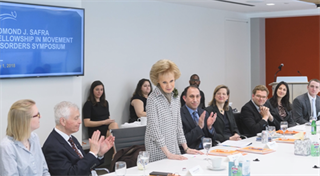
Member Updates
In Memoriam: Jan O. Aasly, 1950-2022
 Neurologist Jan O. Aasly died on June 19, 2022 after receiving a diagnosis of pancreatic cancer the prior summer. Albeit the week he finally elected to ‘retire,’ he never did. He was 71 years old. He leaves his wife, Karin, 3 children, and a growing number of grandchildren.
Neurologist Jan O. Aasly died on June 19, 2022 after receiving a diagnosis of pancreatic cancer the prior summer. Albeit the week he finally elected to ‘retire,’ he never did. He was 71 years old. He leaves his wife, Karin, 3 children, and a growing number of grandchildren.
Jan was born in 1950 in Trondheim, the ancient capital city of Norway and the reginal center for Trondelag (the central northern part of southern Norway). The son of a local farmer, he studied medicine in Oslo, Norway, and earned his PhD at the University of Northern Sweden, Umeå, Sweden. After his service in the armed forces and clinical fellowships in Trondheim and Tromsø in the far north, Jan returned to serve as a Clinical Consultant in movement disorders at St. Olav’s Hospital for more than 40 years. In those years, as a Consultant and Professor at the Norwegian University of Science and Technology, he published more than 245 papers and mentored many MD and PhD students to higher degrees.
Jan was deeply committed to understanding the etiology of Parkinson’s disease and improving its prognosis. His primary work was to care for more than 3,000 patients in central and northern Norway. Through his industry, determination and hard work, he established a longitudinal research cohort, one of the most comprehensively characterized worldwide, to collaboratively address some fundamental questions1,2. Inspired by the work of Roger Duvoisin on the Contursi kindred, Jan also established genealogic and genetic investigations of multi-incident families with Parkinson’s disease in the late 1990s, long before there was much interest in heritability in the field. Whenever possible, he utilized genetics as a foundation for clinical associations and collaborative biomarker studies.
Notably, Jan was first to describe the longitudinal clinical phenotypes of LRRK2 Parkinson’s disease in Norwegian villages3–5. His pedigree work became the basis for the original and only genetic linkage study of LRRK2 p.G2019S to cause disease6, which his efforts helped establish as one of the most important gene targets for disease-modification. Patient need and prevalence prompted Jan to author many LRRK2 studies including more detailed investigations in epidemiology7, penetrance 8–10, pathology11 and biomarkers12–14, as well as longitudinal neuroimaging of manifest and subclinical heterozygotes15,16.
Jan, as a regular participant at Movement Disorders and GeoPD meetings, will be warmly remembered for his clinical acumen, practical discussions, resourcefulness and generosity. Although a head above the crowd, he was always modest, understated and humble to a fault. Jan typically cycled to his clinic, often through ice and snow, albeit equipped with spiked tires for those conditions. As tenaciously, he engaged and encouraged the international clinical and scientific community, seeking to share his journey and insights for translational research. Jan was similarly well-equipped with the wisdom that comes with decades of longitudinal care and a wry wit. As such, Jan’s work enabled the research advances of a great many collaborators and research organizations; he lived a noble life to benefit his patients.
References
- Hustad E, Myklebust TÅ, Gulati S, Aasly JO. Increased Mortality in Young-Onset Parkinson’s Disease. J Mov Disord. 2021;14(3):214-220. doi:10.14802/jmd.21029
- Aasly JO. Long-Term Outcomes of Genetic Parkinson’s Disease. J Mov Disord. 2020;13(2):81-96. doi:10.14802/jmd.19080
- Aasly JO, Toft M, Fernandez-Mata I, et al. Clinical features of LRRK2-associated Parkinson’s disease in Central Norway. Ann Neurol. 2005;57(5):762-765. doi:10.1002/ana.20456
- Johansen KK, Hasselberg K, White LR, Farrer MJ, Aasly JO. Genealogical studies in LRRK2-associated Parkinson’s disease in central Norway. Park Relat Disord. 2010;16(8):527-530. doi:10.1016/j.parkreldis.2010.05.005
- Aasly JO, Vilariño-Güell C, Dachsel JC, et al. Novel pathogenic LRRK2 p.Asn1437His substitution in familial Parkinson’s disease. Mov Disord. 2010;25(13):2156-2163. doi:10.1002/mds.23265
- Kachergus J, Mata IF, Hulihan M, et al. Identification of a novel LRRK2 mutation linked to autosomal dominant parkinsonism: evidence of a common founder across European populations. Am J Hum Genet. 2005;76(4):672-680. doi:10.1086/429256
- Ross OA, Soto-Ortolaza AI, Heckman MG, et al. Association of LRRK2 exonic variants with susceptibility to Parkinson’s disease: a case–control study. Lancet Neurol. 2011;10(10):898-908. doi:10.1016/S1474-4422(11)70175-2
- Hentati F, Trinh J, Thompson C, Nosova E, Farrer MJMJ, Aasly JOJOJO. LRRK2 parkinsonism in Tunisia and Norway: A comparative analysis of disease penetrance. Neurology. 2014;83(6):568-569. doi:10.1212/WNL.0000000000000675
- Healy DG, Falchi M, O’Sullivan SS, et al. Phenotype, genotype, and worldwide genetic penetrance of LRRK2-associated Parkinson’s disease: a case-control study. Lancet Neurol. 2008;7(7):583-590. doi:10.1016/S1474-4422(08)70117-0
- Lai D, Alipanahi B, Fontanillas P, et al. Genomewide Association Studies of LRRK2 Modifiers of Parkinson’s Disease. Ann Neurol. 2021;90(1):76-88. doi:10.1002/ana.26094
- Kalia L V, Lang AE, Hazrati L-N, et al. Clinical correlations with Lewy body pathology in LRRK2-related Parkinson disease. JAMA Neurol. 2015;72(1):100-105. doi:10.1001/jamaneurol.2014.2704
- Delcambre S, Ghelfi J, Ouzren N, et al. Mitochondrial Mechanisms of LRRK2 G2019S Penetrance. Front Neurol. 2020;11:881. doi:10.3389/fneur.2020.00881
- Brockmann K, Apel A, Schulte C, et al. Inflammatory profile in LRRK2-associated prodromal and clinical PD. J Neuroinflammation. 2016;13(1):122. doi:10.1186/s12974-016-0588-5
- Loeffler DA, Aasly JO, LeWitt PA, Coffey MP. What Have We Learned from Cerebrospinal Fluid Studies about Biomarkers for Detecting LRRK2 Parkinson’s Disease Patients and Healthy Subjects with Parkinson’s-Associated LRRK2 Mutations? J Parkinsons Dis. 2019;9(3):467-488. doi:10.3233/JPD-191630
- Wile DJ, Agarwal PA, Schulzer M, et al. Serotonin and dopamine transporter PET changes in the premotor phase of LRRK2 parkinsonism: cross-sectional studies. Lancet Neurol. 2017;16(5):351-359. doi:10.1016/S1474-4422(17)30056-X
- Sossi V, de la Fuente-Fernández R, Nandhagopal R, et al. Dopamine turnover increases in asymptomatic LRRK2 mutations carriers. Mov Disord. 2010;25(16):2717-2723. doi:10.1002/mds.23356
In Memoriam: Lily Safra, 1934-2022
 Mrs. Lily Safra, Chairwoman of the Edmund J Safra Foundation, died in Geneva on July 9, 2022. Together with her husband Edmond, who predeceased her in 1999, she established a remarkable legacy of philanthropic giving, which spanned innumerable areas including humanitarian aid, healthcare, the arts, museums, synagogues, schools and universities, to name just a few.
Mrs. Lily Safra, Chairwoman of the Edmund J Safra Foundation, died in Geneva on July 9, 2022. Together with her husband Edmond, who predeceased her in 1999, she established a remarkable legacy of philanthropic giving, which spanned innumerable areas including humanitarian aid, healthcare, the arts, museums, synagogues, schools and universities, to name just a few.
Dignity was a critical concept that they espoused, sharing the strong belief that those with the financial means have a duty to share their blessings with the less fortunate, acknowledging their equal right to a dignified life. In the last years of his life, Edmond suffered from disabling Parkinson’s disease and Lily experienced firsthand the challenges caused by the disease to patients and their loved ones. Following his tragic death (which his disabled state partially contributed to), Lily became deeply committed to supporting research and medical care for patients with Parkinson’s disease and related brain disorders.
Indeed, few people if any have had as profound a philanthropic impact on the field of Parkinson’s disease. This has included support for a variety of academic research programs, for example at Hebrew University in Jerusalem, University College London and the University of Toronto. Possibly her greatest impact has been through her work with the Michael J Fox Foundation, serving as an early member of their Board of Directors and extensively supporting every one of their important programs, including the Edmond J. Safra Global Genetics Consortia, the Linked Efforts to Accelerate Parkinson’s Solutions (LEAPS) program, the Parkinson’s Progression Markers Initiative (PPMI), and the Edmond J. Safra Fellowship in Movement Disorders. She was especially dedicated to the last of these, enjoying interactions with the Safra Fellows (pictured) and heartened in the knowledge that these young trainees represented the future of Parkinson’s disease patient care and research.
Whether we recognize it or not, few if any health professionals in the field of Movement Disorders have not had their lives touched in some way by Lily Safra. More importantly, it is impossible to estimate or gauge the impact that her giving and leadership has and will continue to have on the lives of patients with Parkinson’s disease and their families.
On a personal note, I was privileged to participate in the care of Edmond over several years before he died, and came to know Lily through many personal interactions in her spousal and caregiving roles. Following Edmond’s death, she and the Foundation have generously supported our program at the University of Toronto, and I have been honoured to hold a chair in Movement Disorders in her name. She had always taken a great interest in our work, and it was especially pleasing for me to see her interacting with the Safra Fellows who were training in our program.
With respect to the Safras’ philanthropic efforts, Lily was quoted as saying “We took joy in giving, as when you support people who are making a real difference in the world, you end up receiving far more than you give.” This was not platitudes and lip service but a genuine commitment to the dignity she celebrated in all people. Lily Safra will be greatly missed, but her legacy, particularly to the readers of this short obituary and the patients they care for, will live on in immeasurable ways.
Authored by Anthony E. Lang OC, MD, FRCPC, FAAN, FCAHS, FRSC
Director, Edmond J. Safra Program in Parkinson’s Disease and the Lily Safra Chair in Movement Disorders, Toronto Western Hospital and the University of Toronto
Read more Moving Along:







